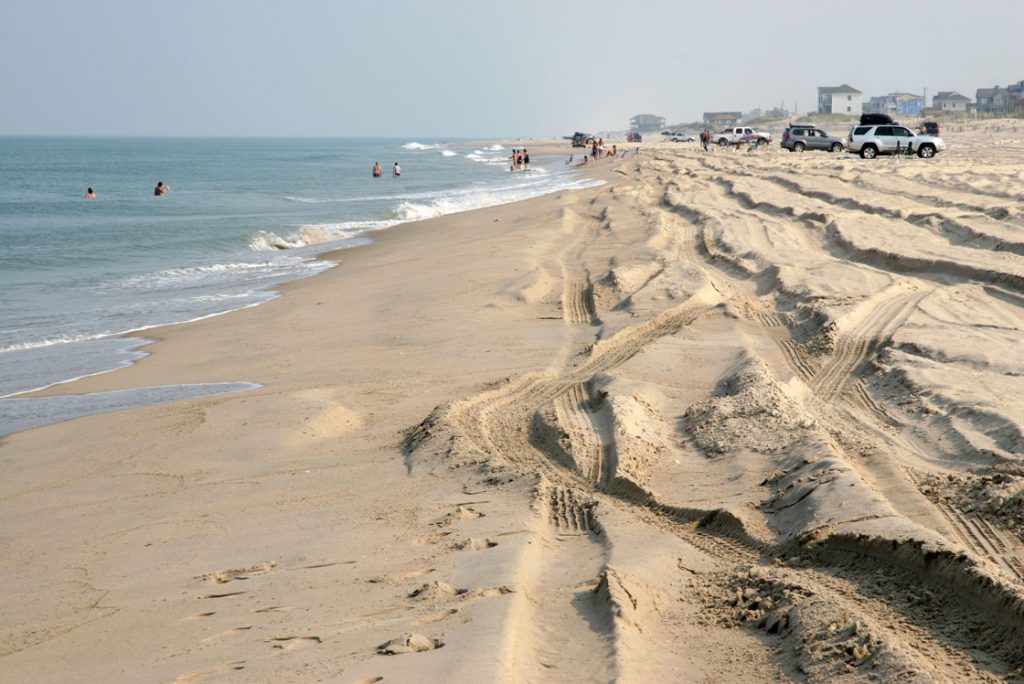National Science Foundation grant to study coastal development
July 11, 2017
The roads on Carova Beach, N.C. are only accessible by 4WD vehicles.
In 2017, the words “bipartisan environmental legislation” may seem like an oxymoron. However, in 1982 when Congress passed a bill called the Coastal Barrier Resources Act (CBRA), a bipartisan solution to environmental issues was not so far-fetched.
CBRA was enacted to protect coastal barriers after Congress realized development along coastlines was not economically or environmentally sustainable. Coastal barriers are highly susceptible to hurricanes, leading to wind and flood damage. They are also home to diverse aquatic and land animals, so development threatens biological diversity.
But has CBRA really made an impact on development patterns along the coast?
This is the question Todd BenDor, David Salveson and Nikhil Kaza are exploring in their upcoming research, made possible by a National Science Foundation grant.
Although CBRA covers over one million acres along the east coast and Gulf of Mexico, development persists in many places, funded by private investors and local governments.
Take Carova Beach, for example. It is nestled on North Carolina’s Outer Banks, less than five miles from the Virginia border. The lack of infrastructure and lack of accessibility (anyone visiting the beach must have a 4WD car or truck) do not deter the thousands of visitors that flock to the beach each summer.
Starting July 2017, BenDor, Salveson and Kaza will explore patterns of develop on coastal areas in North Carolina, Texas, Florida, Alabama and Delaware.
Although the idea for the project originated with Salvesen, whose area of expertise is land use policy and climate change, the interests of all researchers are represented. BenDor, associate professor and director of the City and Regional Planning Ph.D. program, primarily focuses on how human development impacts sensitive ecosystems. Kaza, associate professor and Director of the City and Regional Planning Master’s program, studies how plans are used in public and private decision making, with a focus on energy planning, land use impacts and urban development processes.
The two-year grant will allow the researchers to gather data from local governments, assess aerial photos and do case studies of individual people who are affected by CBRA.
Each CBRA site was chosen for a unique reason.
“All the areas have very different growth patterns and storm issues,” BenDor says. “The idea is basically to look at those and say, ‘Some areas are growing and some are not, some have had subsidies removed through part of the Coastal Barrier Resources Act and some of them haven’t.’”
To imitate a truly random sample, the team will use a quasi-experimental design. Quasi-experimental designs allow researchers to control for various factors outside of CBRA that may have impacted development and give a better idea of growth patterns.
Another part of the team’s research will include determining if it would be useful or feasible to structure other laws like CBRA. CBRA is unique in that it does not outlaw coastal development, instead it acts merely as a disincentive. BenDor notes that it is possible development would be stopped or slowed in CBRA areas eventually anyway, mostly due to the financial burden of maintaining infrastructure in volatile areas.
BenDor is hopeful about the impact of the project. It has the potential to shape future legislation, as well as discourse that surrounds city planning and environmental issues.
“The implications of this project are interesting,” BenDor says. “It’ll be important to discover how effective it is to target subsidies [to remove] and to do so in a socially or developmentally conscious way.”
